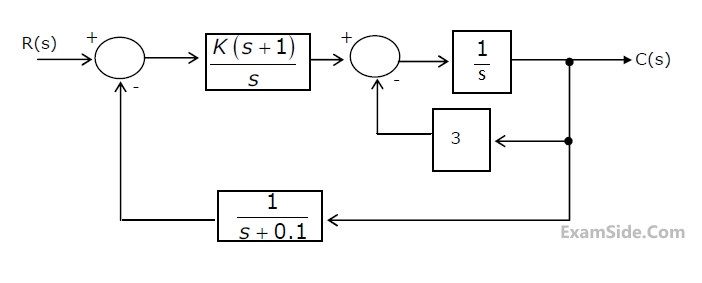1
GATE ECE 2001
Subjective
+5
-0
Consider the feedback control system shown in figure.

(a) Find the transfer function of the system and its characteristic equation.

(a) Find the transfer function of the system and its characteristic equation.
(b) Use the Routh-Hurwitz criterion to determine the range of 'K' for which the system is stable.
2
GATE ECE 1999
Subjective
+5
-0
The loop transfer function of a feedback control system is given by $$$G\left(s\right)H\left(s\right)=\frac{K\left(s+1\right)}{s\left(1+Ts\right)\left(1+2s\right)},\;K>0$$$ Using Routh-Hurwitz criterion, determine the region of K-T plane in which the
closed-loop system is stable.
3
GATE ECE 1998
Subjective
+5
-0
The characteristic equation of a feedback control system is
$$$s^4+20s^3+15s^2+2s+K\;=\;0$$$
(i) Determine the range of K for the system to be stable.
(ii) Can the system be marginally stable? If so, find the required value of K and the frequency of sustained oscillation.
(i) Determine the range of K for the system to be stable.
(ii) Can the system be marginally stable? If so, find the required value of K and the frequency of sustained oscillation.
4
GATE ECE 1996
Subjective
+5
-0
A system having an open loop transfer function
$$G\left(s\right)=\frac{K\left(s+3\right)}{s\left(s^2+2s+2\right)}$$
is used in a
control system with unity negative feedback. Using the Routh-Hurwitz criterion,
find the range of values of 'K' for which the feedback system is stable.
Questions Asked from Stability (Marks 5)
Number in Brackets after Paper Indicates No. of Questions
GATE ECE Subjects
Network Theory
Control Systems
Electronic Devices and VLSI
Analog Circuits
Digital Circuits
Microprocessors
Signals and Systems
Representation of Continuous Time Signal Fourier Series Fourier Transform Continuous Time Signal Laplace Transform Discrete Time Signal Fourier Series Fourier Transform Discrete Fourier Transform and Fast Fourier Transform Discrete Time Signal Z Transform Continuous Time Linear Invariant System Discrete Time Linear Time Invariant Systems Transmission of Signal Through Continuous Time LTI Systems Sampling Transmission of Signal Through Discrete Time Lti Systems Miscellaneous
Communications
Electromagnetics
General Aptitude